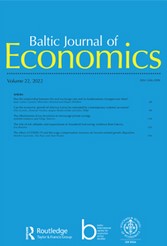Wage growth in Lithuania from 2008 to 2020: observed drivers and underlying shocks
Wage growth in Lithuania from 2008 to 2020: observed drivers and underlying shocks
Author(s): Jose Garcia-Louzao, Valentin JouvanceauSubject(s): Public Administration, Economic history, Labor relations, Transformation Period (1990 - 2010), Present Times (2010 - today), Socio-Economic Research
Published by: BICEPS/SSE Riga
Keywords: Wage growth; Phillips curve; structural BVAR; administrative data;
Summary/Abstract: This paper studies the drivers of wage growth in Lithuania over the period 2008–2020. Using administrative data as well as aggregate measures reflecting the state of the economy, we estimate an extended version of a wage Phillips curve. Our reduced-form estimates indicate that nominal wage growth was tightly linked to labor market fluctuation over this period. Labor productivity, changes in the minimum wage, and the composition of employment also contributed to wage dynamics. However, we find little evidence that past inflation has been a push factor. To understand the underlying economic primitives behind our findings, we estimate a structural Bayesian autoregressive model. Our structural analysis reveals a significant contribution from aggregate supply shocks, reflecting a stronger relationship between productivity and wages than implied by our reduced-form estimates. Moreover, a historical decomposition reveals that since 2013, wages grew over and above productivity due to rising aggregate demand and labor market disturbances.
Journal: Baltic Journal of Economics
- Issue Year: 23/2023
- Issue No: 2
- Page Range: 117-141
- Page Count: 25
- Language: English

